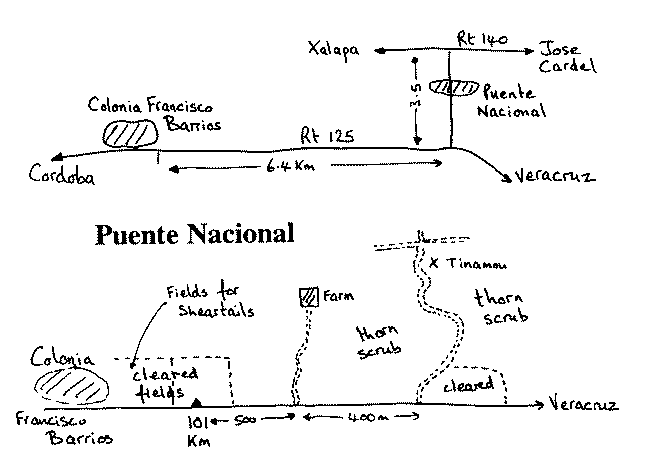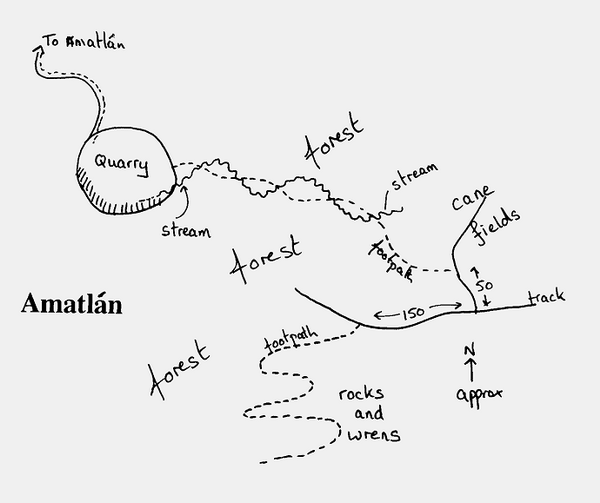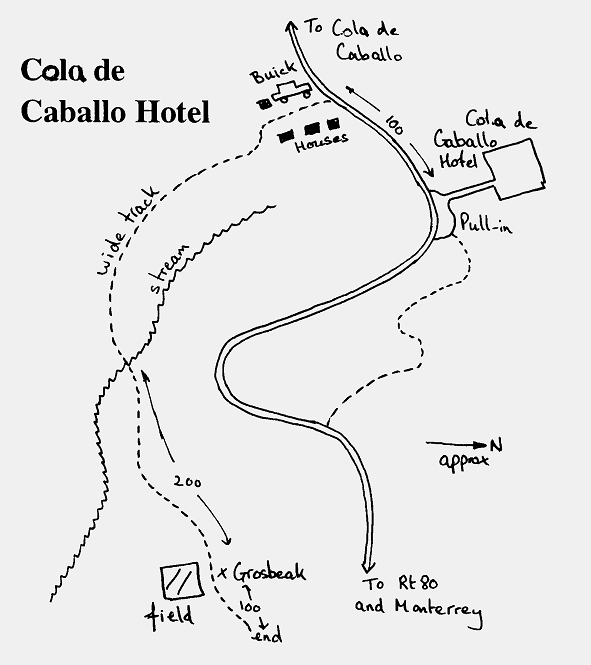Section 1 - Introduction, logistics, itinerary and general information.
Section 2 - Birding sites (Nuevo León to Veracruz).
Section 3 - Birding sites (Oaxaca to Coahuila).
Section 4 - Annotated checklist.
Section 5 - Other references and bibliography.
|
Birding SitesIncluded below are details of access, habitat and species lists for all sites we visited. Some are well-known birding localities, while others are new localities found ourselves. They are listed in the order in which we visited them, from Monterrey southward down the eastern side of the country, returning on a more westerly route through Mexico City. Other birding sites of importance are described in the list of birds at the end of this report. For the species list, a 'c' denotes that the bird was common or fairly so. |
Site M1. Cola de Caballo, Nuevo León.
Cola de Caballo, 550-1,900 m, is the best, and probably the only reliable, place to find the Maroon fronted Parrot, an endemic species listed as vulnerable in the Red Data Book (Collar et al. 1992). Here, at 2,000 metres, they breed in cavities on sheer cliffs above dry, forested country.
Approximately 40 km south of Monterrey on Highway 85, turn right (west), on the well signposted road to Cola de Caballo. Zero the oedometer at this turn-off. From here the road winds uphill through villages and scrub. You will pass the Cola de Caballo Hotel on your right after 5.5 km, and the Cola de Caballo waterfall at 6.9 km. The road continues through picturesque forests and gorges, the village of Cienaga, and then through the village of San Isidro. At 34.9 km, just inside the village of San Isidro, turn hard right by the village store onto a gravel road, which is signposted "S. José de Boquillas". Follow this gravel road, keeping right at a large, cleared area (road maintenance?) at 35.4 km. At 38.5 km you will find one of the few flat areas suitable for camping, with the cliffs towering above the forest on the left (south) side of the road. The birds are present at least between April and November, when they breed and roost in cavities in the cliffs. From the road it is only possible to obtain distant views of birds passing high overhead. It is an hour’s hard slog uphill through the forest to get to the base of the cliffs, where you should have stunning views. The parrots are noisy and call often, although it is not easy to spot them. They fly much higher than imagined from the call.
|
Time permitting, it is worthwhile to bird along the road as far down as the Cola de Caballo Hotel at 550 metres. We found one particularly good area - the “Buick” track - near the hotel. From the hotel entrance, walk uphill 100 metres, to where an abandoned Buick 1940 Special rests, collecting dust. Walk though the area of houses there, and follow the wide track down through secondary forest. It was along there that we had Crimson-collared Grosbeak and we found Spot-breasted Wren in roadside scrub at the hotel entrance.
Species recorded at Cola de Caballo:
Mallard 20 |
Brown Creeper 1 |
Site M2. Rancho Los Colorados, Tamaulipas
Rancho Los Colorados is a private ranch, located northeast of Aldama (north of Tampico) on the Barra El Toro road. Ernesto Enkerlin, who was studying Amazona parrots on Rancho Los Colorados, took us to a study site where we could observe nests of both Red-crowned Parrot and Yellow-headed Parrot, and then showed us around the ranch. Rancho Los Colorados is mentioned in the ICBP’s Red Data Book as one of the last strongholds for Yellow-headed Parrot, but the Red Data Book erroneously suggests that parrots at the ranch have taken to artificial nest boxes. The owner of Rancho Los Colorados, Roberto Klein, is interested in wildlife conservation, and has left a substantial number of mature trees standing on the property. As might be expected, the area holds many other interesting species. The highlight of the first Rancho Los Colorados Christmas Bird Count, held in 1992, was Great Curassow.
Visitors to the ranch may stay in a bungalow with three beds and a bathroom. It is quite comfortable and convenient. A charge of $10 per person per night is levied and donated to parrot conservation. All would-be visitors should contact Ernesto Enkerlin in advance. A final word of warning - the abundance of ticks, both large and very small, in the grasslands here is unbelievable. Use a good insect repellant, and tuck trousers into socks.
Species recorded at Rancho Los Colorados:
Black-bellied Whistling-Duck 6 |
Boat-billed Flycatcher 2 |
Site M3. Tlanchinol, Hidalgo
Cloud forest, at 1,450 m, between 4 and 8 km north of Tlanchinol (190 km south of Tampico), along Rt. 105 was first bought to our attention in an article by Howell and Webb. We decided to visit on the possibility of locating Bearded Wood-Partridge. The one day we spent was completely inadequate, and we would recommend that birders allow at least two days, possibly longer, to stand any success of relocating the Wood-Partridge. Travelling north from Tlanchinol, pass the "Pollo al Hornero" chicken restaurant on the right and look for a pullover on the left with space for several cars. This is marked by a sign reading "Lontla", and is about 5 km north of Tlanchinol.
Much of the forest down-slope from the road has suffered minimal disturbance and would appear to remain suitable habitat for Bearded Wood-Partridge. There is less extensive forest on the other side of the road, and it seemed to hold fewer birds. Among the birds observed were Crested Guan, White-faced Quail-Dove, Mountain Trogon, Ruddy Foliage-Gleaner, Scaled Antpitta, Azure-hooded Jay, Unicoloured Jay, Brown-backed Solitaire, Black-headed Nightingale-Thrush, and Black Thrush. The main trail continues far down-slope to a village. With more time, it would be worthwhile to continue down to the valley below. In August, 1993, Karl Overman found Crimson-collared Grosbeak south of Tlanchinol along the road to the Otongo industrial zone, across the valley from Molango. In July, 1994, John Gee found Hooded Yellowthroat, White-throated Flycatcher, Crested Guan, Bumblebee Hummingbird, White-naped Brushfinch and Azure-hooded Jay at a small pulloff about 1 mile south of the southern edge of Tlanchinol. The Yellowthroats were downslope on the west side of the road and just south of the pulloff. In 1994, John Gee also discovered a spot for Black-polled Yellowthroat south of Tlanchinol on the road to Pachuca. About 5 miles south of Molango, there is a large pond on the east side of the road. Hooded Yellowthroats were found in trees and shrubs around this pond. Across the road from the pond is a large, apparently manmade hill of gravel or shale and asphalt. An unpaved road goes up this hill. Near the top, on the left, is a pond with some open water. A pair of Black-polled Yellowthroats were found in bushes around the upper pond. No accommodation is available in Tlanchinol, but the excellent Hotel Conchita is located about 18 km (½ hour) south of Tlanchinol on Rt. 105 in Ixtlahuaco.
Species recorded at Tlanchinol: (Karl Overman's observations in August, 1993 are referenced as KO).
Red-tailed Hawk 1 |
Cliff Swallow (KO) |
Site M4. Puente Nacional, Veracruz
This is a good, and in fact the only, stakeout for Mexican Sheartail in Veracruz. Puente Nacional is just off Rt. 140, the east-west highway from José Cardel to Xalapa, about 60 km north-west of Veracruz City. Driving west on Rt. 140, turn off left (south) about 13 km west of José Cardel, through the village of Puente Nacional. A further 3.5 km brings you to a confusingly signposted junction at which you should turn right onto Rt. 125. You are now again travelling west, and after driving another 6.4 km, and passing some interesting-looking dry thorn forest, you will arrive at the small village of Colónia Francisco Barrios. On the north side of the road, immediately before the village you should find the 101 kilometre post, and two completely overgrazed fields (which look to be the poorest habitat in the area). Look for the Sheartail in the tops of the few bushes that remain in the overgrazed fields.

The area can be explored further, from two tracks leading northward off the road, 0.5 km and 0.9 km before the 101 km marker. The track at 0.9 km is the better of the two, and gives access to large areas of thorn brush, where Thicket Tinamou is common, and Buff-collared Nightjar possibly may be found.
Species recorded at Puente Nacional:
Thicket Tinamou 10h |
Great Kiskadee 10 |
Site M5. Amatlán, Veracruz
Amatlán, at an altirude of 900 m, is located 5 km south of Córdoba. Forested, limestone hills to the south of Amatlán are one of the very few places where Sumichrast's Wren can be found. The nominate form, Hylorchilus sumichrasti, which occurs in the Córdoba area of Veracruz, recently has been split from Nava's Wren, H. navai, which occurs in eastern Veracruz (around Uxpanapa) and Chiapas. The undergrowth of the original primary forest covering these hills has been cleared for coffee. However, some large trees remain as shade-forest, and the tangled understorey proves still to be suitable for the wren. Although difficult to find, a trail winds through the hills. The strange mixture of rocky outcrops within shade-forest really feels ancient and mystical. Starting from the intersection of Calle 7 and Avenida 11 near the centre of Córdoba, drive south on Avenida 11 (about 1 km?), to a fork in the road with a Pemex station lying in the fork. (Note that the Pemex station is slightly shielded by some trees as you approach). Keep right at the fork and follow the road as it winds through a built-up area, past the railway station (on the right), and over three separate sets of railway tracks. Zero the oedometer at the last railway crossing.

Keep directly ahead, and follow the road through the sugar-processing factory area. Cross the autopista at 0.8 km, and continue straight ahead to the village of Amatlán. Once in the village, head for the village square (zócalo) (look for church tower), which will be at 2.3 km. From the square, continue on the road from the south-east corner, which should be diagonally opposite to the road on which you arrived. This road soon turns to gravel, and comes to a fork at 4.0 km. Turn left at the fork and drive into the quarry at 4.4 km. From the quarry, follow the narrow footpath along the stream, which starts on the opposite side from which you arrived. The path crosses the steam several times, then veers away from it, and after about 600 metres from the quarry, exits the forest to arrive at a wide track next to a sugar cane field. Turn right, walk 50 metres, and turn right again on another wide track, which leads back into the forest again. After approximately another 150 metres, a narrow, but obvious, trail leads off left into the hills. This is the main trail through the hills, and continues for at least the kilometre we followed it.
Species recorded at Amatlán:
Black Vulture c |
Boat-billed Flycatcher 2 |
Section 1 - Introduction, logistics, itinerary and general information.
Section 2 - Birding sites (Nuevo León to Veracruz).
Section 3 - Birding sites (Oaxaca to Coahuila).
Section 4 - Annotated checklist.
Section 5 - Other references and bibliography.


